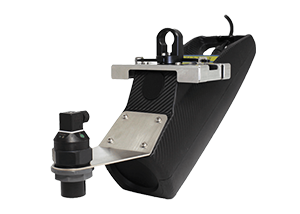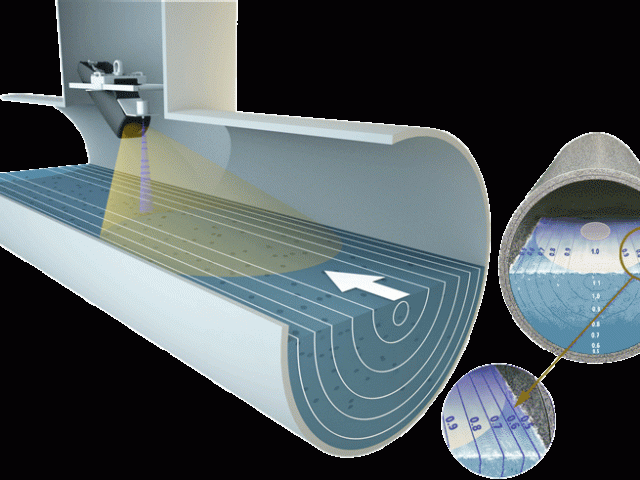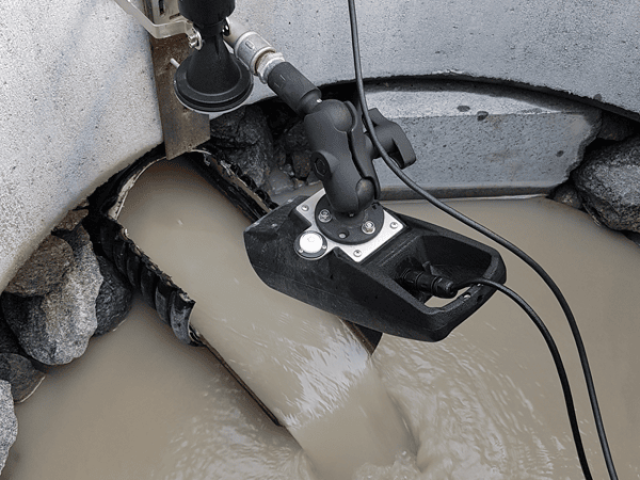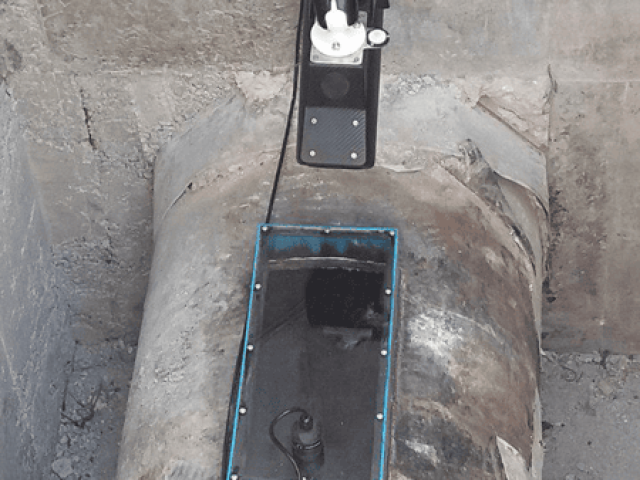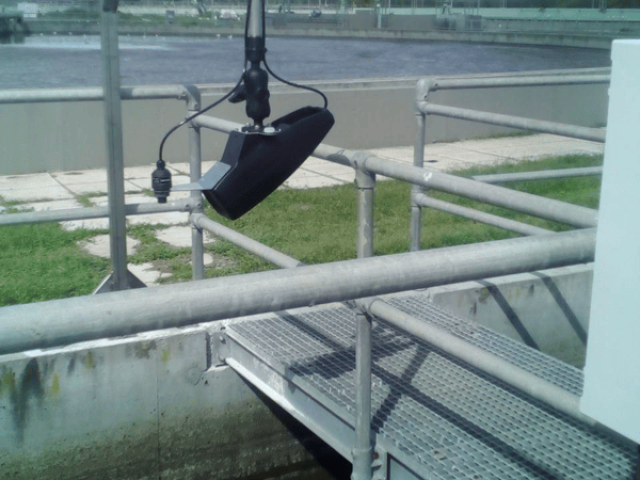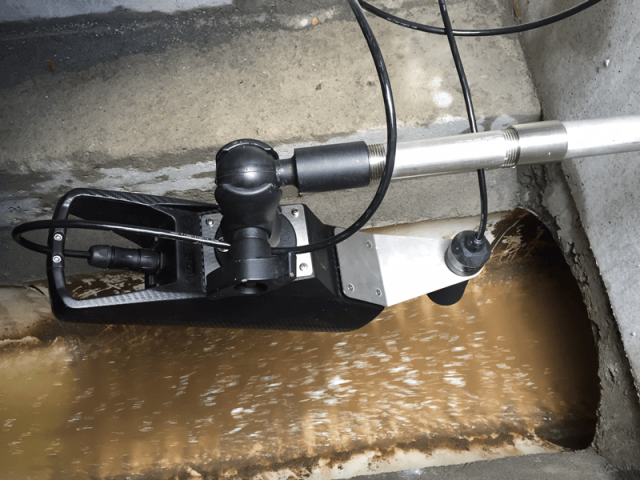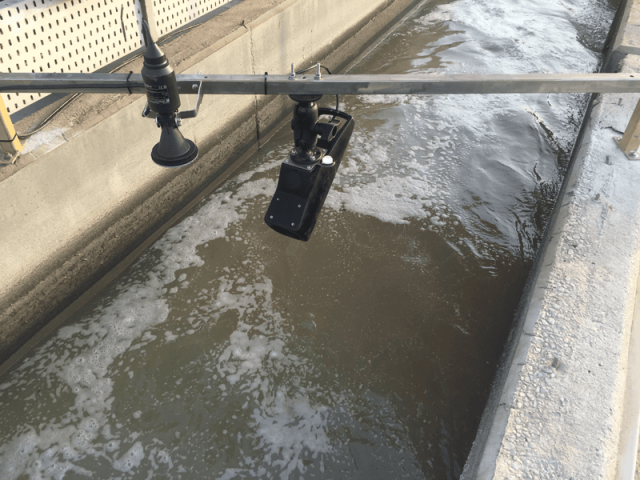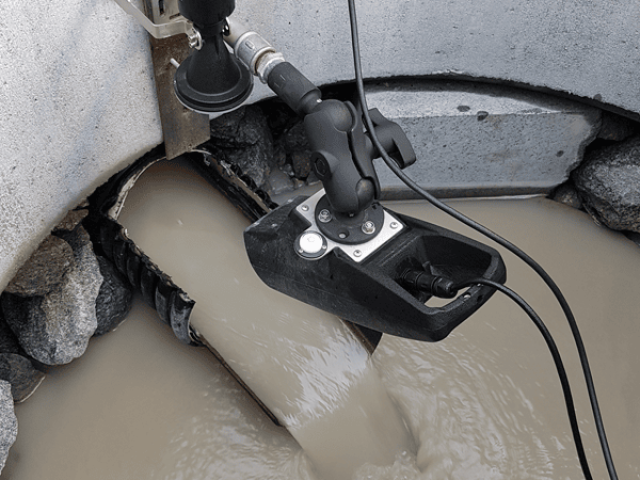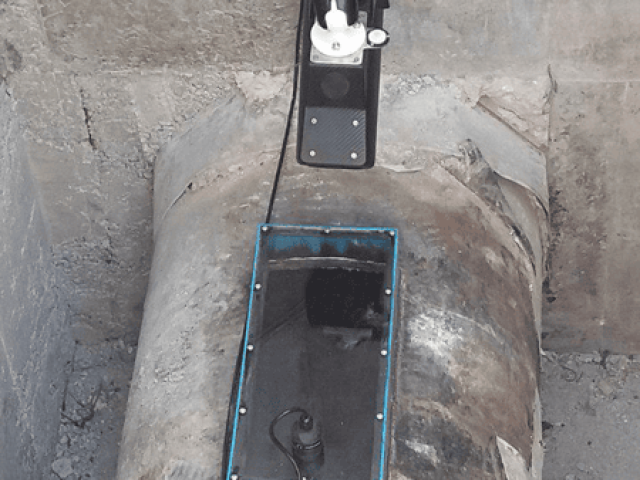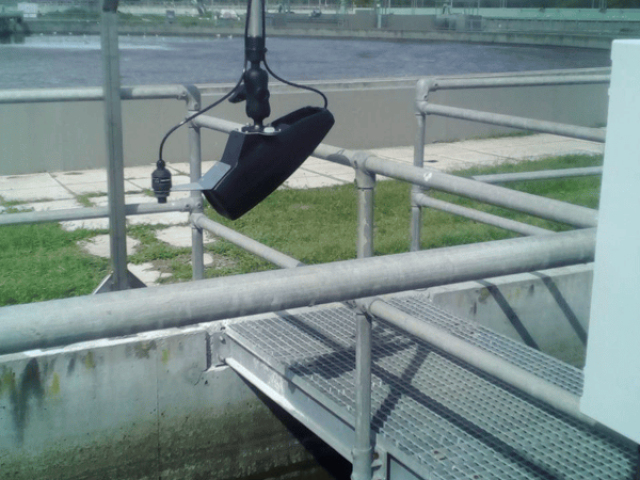The new non-contact flowmeter with radar technology represents a revolution in the industry of liquid flow measurement in open channels, sewage tunnels, rivers, water treatment plant inlets and outlets, as well as partially filled pipes. This flowmeter, without any need of contact with the fluid and utilizing radar-Doppler technology, is capable of measuring fluid velocity with high accuracy, even at very low to high velocities (from 0.15 to 20 meters per second). It is suitable for any type of channel with a cross-sectional area starting from 10 centimeters and does not require flow interruption for installation and commissioning. The advantages of radar technology, in addition to being non-contact, include high strength, simple and easy installation, no special maintenance requirements, and an actual IP68 protection rating, ensuring taking no damage even if the device is submerged.
The performance of this device remains excellent even when the channel surface is covered with wood or plastic coating. The special design and high-quality production of the radar sensor, along with its cost-effectiveness, have made non-contact flowmeters the first choice for flow measurement in various types of channels in Europe and America. Currently, over 1000 units of the Raven-Eye radar flowmeters, manufactured by Flow-tronic, have been installed and commissioned throughout Europe.
- No need to interrupt flow during installation
- Easy and straightforward installation using three-position levers
- Extremely long lifespan
- No periodic cleaning or maintenance of sensors required
- Sensor corrosion and erosion-free
- No special maintenance required
- Extremely low maintenance costs
- True IP68 rating, ensuring complete sealing of system components with no visible screws, bolts, washers, etc.
Brief explanation of contact liquid flowmeters problems:
As we know, to measure the flow rate of a fluid in a channel, we need to measure both the velocity and the level of the liquid. In ultrasonic contact systems, ultrasonic sensors are used to measure the velocity, which needs to be installed at the bottom of the channel in contact with the liquid. However, in some locations, this can be difficult or even impossible, and it often requires interrupting the flow of the fluid. Regular cleaning of the sensor is also necessary to remove deposits that accumulate on its surface. This issue is more severe in channels that carry wastewater or industrial water, as the sensor surface is not only subject to gradual wear but also to impacts from suspended solids in the incoming wastewater, leading to sensor erosion. Consequently, the lifespan of the sensor can be less than a year in some cases, requiring frequent repairs or replacements.
Working principle of radar flowmeter system:
The Raven-Eye radar flowmeter is installed above the fluid surface, and it uses Pulsed Digital Doppler Radar technology to accurately measure the average fluid velocity. The fluid level is also measured using a level sensor (ultrasonic, radar, or pressure), and based on the cross-sectional area, the volumetric flow rate is calculated using the continuity equation Q=V×A per unit time. During each measurement cycle, thousands of velocity samples are taken, and the digitally powerful signal processor performs spectral analysis over time on the measured average velocities.
As shown in the image, the velocity parameter varies at different sections across the channel width. Therefore, the device starts measuring the velocity distribution across the entire channel width and stores it in its memory. By considering the installation distance of the device from the fluid surface, the angle of radar wave radiation, and the angle of the device relative to the fluid surface, the exact coverage area of the measurement is determined. As a result, the Raven-Eye automatically adapts the measured velocities to the coverage area and fluid height. The device works even when the channel surface is covered with wood or plastic.
Advantages of the Raven-Eye radar flowmeter:
- Accurate flow measurement
- Economical and cost-effective
- Available in fixed and portable installation models
- No contact between the sensor and the fluid (the sensor is installed above the fluid surface)
- Simple and easy installation and setup
- Highly durable structure with IP68 protection rating
- Integrated and fully encapsulated sensor without joints, screws, or bolts
- Developed for various practical applications
- Velocity distribution analysis and self-learning technology for calculating average velocity
- Suitable for channels with a diameter of 100 mm and above
- Easy compatibility with SCADA, PLC, and telemetry systems
- Sensor with direct RS485 output port without the need for monitoring panels or other converters
- 4-20 mA current output with adjustable capability
- Ideal solution for challenging conditions such as high solid content, high temperature, low and fast flow rates, high velocities, and large open channels
- No special maintenance or repair requirements
- Features automatic self-diagnostic capabilities.
The selection of the name “Raven Eye” for this product was not random; it reflects three key characteristics that resemble those of a raven: Intelligence, Adaptability, and Survivability.
Intelligence: The velocity sensor of this device uses radar technology to measure the velocity and fluid level. The average velocity is calculated through the sensor’s self-learning capability, which analyzes the velocity distribution on the fluid surface. This eliminates the need for theoretical models or on-site calibration. Negative effects from non-ideal flow conditions such as turbulence and wave interference are eliminated.
Adaptability: Raven Eye can be used in most open channels with water depths of 10 centimeters and above, and with a wide range of flow velocities, from very low speeds of 15 centimeters per second to 9 meters per second. This device is ideal and robust, equipped with industrial MODBUS output and standard analog output, making it compatible with SCADA systems, PLCs, and telemetry networks. It can also function as a standalone system, displaying flow rates, recording data, and transferring it to remote servers or computers.
Survivability: The manufacturer of Raven Eye, leveraging years of experience in fluid flow measurement devices, has developed this device as a fully integrated unit without the use of joints, seals, screws, or washers. It has an IP68 protection rating and is highly resistant to unforeseen incidents or problematic fluids. An internal sensor monitors the overall system health and provides reports. This combination of advantages reduces maintenance and repair costs.
Applications and Usage Locations:
- Sewage Networks/Network Channel Monitoring:
- Large sewage channels, capacity studies, combined sewer overflow (CSO) studies, flow and infiltration studies, high-velocity flows, tank or basin discharge.
- Wastewater Treatment Plants
- Measurement of inflow to treatment plants, effluent or discharge measurement, industrial wastewater measurement, measurement and discharge of stormwater, flow process control.
- Rivers and Irrigation Channels:
- Flood monitoring and compliance with standard values, weather and hydraulic engineering, stormwater basin calculations, continuous measurement of surface waters.
- Industries and Hydropower Plants:
- Measurement of industrial wastewater and effluents, measurement of flow with high suspended solids, measurement of cooling water flows, industrial compliance monitoring, measurement of flows of combustible and corrosive fluids.

